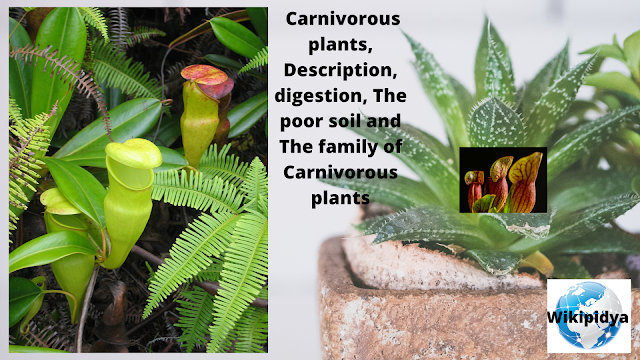Carnivorous plants, Description, Types of traps and digestion, The poor soil and The family of Carnivorous plants
Carnivorous plants
Description
Any plant specifically specialized for collecting and digesting insects and other animals by the use of cunning pitfalls and traps is known as a carnivorous plant, sometimes known as an insectivorous plant. Across multiple families and orders, carnivory in plants has independently evolved roughly six times. A relatively varied group, the more than 600 species of known carnivorous plants share nothing more than their carnivorous behavior in some situations.
Types of traps and digestion
Prey
Small
insects including gnats, flies, bees, moths, beetles, and ants are the most
typical food for carnivorous plants. And the adaption miracles of how these
unfortunate creatures become food. Carnivorous plants have a variety of lures
in their bag of bug-grabbing gimmicks. The plants lure their prey with vivid
colors and a range of fragrances to tempt them near enough to catch. But with
odors, one's perception of beauty depends on their nose. Some carnivorous
plants have floral, pleasant odors, while others smell like cat urine or even
dead animals.
These plants catch people's attention because of their ostentatious trapping mechanism, which is invariably a modified leaf. There are many different types of trapping devices, and depending on whether they move to seize prey, they are classified as active or passive. One of the most popular forms of traps, pitfall traps uses a hollow, closed leaf filled with liquid to passively capture and digest prey, like those seen in pitcher plants.
using enzymes
Carnivorous
plants digest their food by a chemical breakdown process akin to vertebrate
digestion using enzymes or bacteria.
The poor soil
Carnivorous plants may live in a broad range of environments, from sluggish, freezing streams to alkaline pine swamps and sweltering, tropical rainforests. However, all carnivorous plants share one thing in common: extremely poor, practically sterile soils where few plants can even survive, let alone flourish. Under normal circumstances, soil microbes and the breakdown of plant and animal debris make critical nutrients accessible. However, certain ecosystems make it challenging for soil bacteria to carry out their duties. For instance, flooding stops the soil from receiving a healthy amount of oxygen, and certain extremely saturated soils are referred to be "wet deserts."
Whether plants
eat insects or meat, aquatic or terrestrial, they grow in the same habitat.
Frequently, species from two or three genera—for instance, Sarracenia, Drosera,
and Pinguicula—grow virtually parallel to one another. The majority are
frequently found in wet swamps, bogs, muddy or sandy beaches, and other wet
areas where water is present at least seasonally but nitrogenous elements are
sparse or nonexistent because of soil conditions like acidity or other
unfavorable soil characteristics. The sole apparent exception is the fruit fly,
which is found in Portugal and Morocco on arid, gravelly slopes.
Even while
carnivorous plants tend to be tiny on average, there is a wide range of sizes
among species of the same genus. The great majority of perennial herbaceous
species are typically just 10 to 15 cm (or less than 1 foot) tall (4 to 6 in).
However, some buckthorn plant species develop into massive shrub vines. Most
frequently, the tiniest Drosophila species are concealed under the sphagnum
moss. Drosophila species range from a few centimeters to 1 meter (3 feet) or
more in height (D. gigantea).
The family of Carnivorous plants
Lentibulariaceae (order Lamiales), the biggest of the carnivorous plant families, is characterized by symmetrical, bilateral blooms with small petals and just two anthers. This family has more than 300 species in three genera, including spiral plants, bladderwort (Utricularia, around 220 species), and butterflies (Pinguicula, about 80 species) (Genlisea, about 22 species). Members of the family are mostly herbivores from damp or watery settings and feed on insects and other invertebrates using a variety of trapping techniques.

